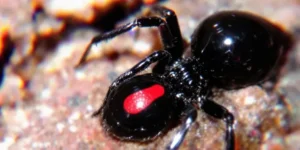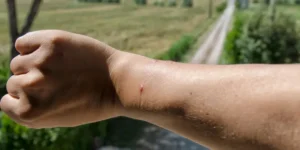Redback spiders, known for being redback spider poisonous, pose a significant danger in Australian gardens. These small yet highly venomous spiders deliver a painful, toxic bite. This article will show you how to identify redbacks and the proper steps to take if bitten.
Protect yourself from these hazardous arachnids!
Key Takeaways
- Redback spiders are small but very toxic. They have a black body with a red stripe on their back.
- These spiders live all over Australia. They like warm, dark spots near homes.
- A redback bite can cause bad pain, sweating, feeling sick, and headaches. It can last for days.
- If bitten, clean the bite, use a cold pack, and get medical help fast. Doctors may use antivenom to treat bad bites.
- To stay safe, wear gloves when gardening, check shoes before wearing, and keep your yard tidy. This helps avoid redback spider bites.

What Is a Redback Spider?

Redback spiders are small yet highly venomous arachnids found throughout Australia. They’re recognised by their black bodies and distinctive red stripe on their backs.
Scientific Name and Classification
The redback spider’s scientific name is Latrodectus hasselti. It is part of the widow spider group in the Theridiidae family. Swedish scientist Tamerlan Thorell named this spider in 1870.
He selected “hasselti” to honour his friend A.W.M. van Hasselt. Thorell initially observed this spider in Rockhampton and Bowen, Queensland.
Specialists categorise the redback spider with other widow spiders. These spiders are recognised for their potent venom. The redback is part of the Latrodectus genus. This group comprises about 30 species of widow spiders found globally.
In Australia, the redback is the most prevalent of these spiders.
Appearance and Identification
Redback spiders have a distinctive appearance. Adult females measure approximately 10 mm in length with a round black body. A vivid red stripe extends along their back. On their underside, a red or orange hourglass shape is visible.
These markings make them easily identifiable.
Male redbacks are significantly smaller, measuring only 3-4 mm. They have a light brown colouration with white markings and a pale hourglass on their underside. Both males and females possess eight legs, as do all spiders.
Their characteristic colouring allows for quick identification. The next section will examine the habitats and distribution of these spiders.
Habitat and Distribution
Redback spiders prefer warm, sheltered spots near homes. They construct irregular webs in dark corners, sheds, and under outdoor furniture. These arachnids flourish in urban areas across Australia.
They are frequently found in gardens, garages, and even inside houses.
These spiders have expanded beyond Australia’s shores. They now inhabit New Zealand, Japan, and parts of Europe. In 2007, the first redback bite was documented in New Caledonia. Japan has been responding – in 2012, they eliminated over 4,600 redbacks in Fukuoka alone.
The UAE has also experienced these Australian visitors establishing themselves.
Symptoms of a Redback Spider Bite
Redback spider bites can cause intense pain and other serious effects. The pain typically begins immediately and intensifies over time. It may extend from the bite location to other areas of the body.
Individuals might experience excessive sweating, nausea, vomiting, and severe headaches. These symptoms can persist for hours or even days.
Children who are bitten may exhibit different reactions. They might become unusually irritable and lose their appetite. Some develop a red rash on their skin. In uncommon instances, children can experience neck spasms as well.
Annually, approximately 2,000 to 10,000 bites occur in Australia. Some individuals also experience significant anxiety or distress following a bite. They may have elevated blood pressure and chest discomfort.
If you suspect you’ve been bitten, it’s advisable to seek medical attention promptly.
Treatment for Redback Spider Bites
Redback spider bites require prompt and appropriate care. Here’s what you should know about treating these dangerous bites:
- Seek medical attention immediately if bitten
- Clean the bite area with soap and water
- Apply a cold pack to reduce pain and swelling
- Take pain medicine like paracetamol if needed
- Antivenom is the primary treatment for severe bites
- Doctors have used antivenom since 1956 to treat bites
- Each dose contains 500 units of specific antibodies
- Antivenom aids with severe systemic symptoms
- Approximately 3-5% of people may experience an adverse reaction to antivenom
- There’s a minimal 1-2% risk of a severe allergic reaction
- Some individuals develop symptoms about 10 days after antivenom administration
- Doctors administered antivenom 344 times in 1995
- By 2011, usage decreased to about 200 times per year
- Your doctor will monitor you closely after administering antivenom
- Most people recover well with appropriate and swift treatment
Supplementary Information on Redback Spiders
Redback spiders possess distinctive characteristics that distinguish them from other arachnids. For more information on their behaviours and how they contrast with similar species, refer to the comparison table and safety tips below.
Redback Spider vs. Black Widow Spider (Comparison Table)
Redback spiders and black widow spiders share many traits, but they have key differences. We can compare these two venomous arachnids:
| Feature | Redback Spider | Black Widow Spider |
|---|---|---|
| Location | Australia | United States |
| Markings | Red stripe on abdomen | Red hourglass on abdomen |
| Venom Effects | Latrodectism, severe pain, sweating, nausea | Similar to redback, but can be more severe |
| Antivenom Available Since | 1956 | 1930s |
| Web Preference | Untidy webs near homes | Dark, quiet areas |
| Bite Duration | Pain can last over 24 hours | Similar to redback |
| Mating Behaviour | Females may eat males after mating | Females may eat males after mating |
Both spiders belong to the Latrodectus genus. They’re known for their potent venom. The redback’s bite can cause pain for over a day, but it’s rarely deadly. Both species show sexual cannibalism during mating. RedBackSpider.com provides additional information on these spiders and their habits.
Precautions to Avoid Redback Spider Poisonous Bites
Redback spiders pose a serious threat to Australians. Taking simple steps can help you avoid their painful bites.
- Wear gloves when working in the garden or moving outdoor items
- Check shoes and clothing before putting them on, especially if stored outside
- Keep outdoor areas tidy and free of clutter where spiders can hide
- Seal cracks and gaps in walls, floors, and around windows to prevent spiders entering
- Use insect screens on doors and windows to keep spiders out
- Shake out stored items like towels or blankets before use
- Be careful when reaching into dark spaces like letterboxes or under rocks
- Keep grass and bushes trimmed away from buildings
- Remove spider webs regularly from around the home
- Use a torch to check dark areas before reaching in
- Teach children to be spider-aware and not to touch webs or spiders
- Keep bins sealed and away from the house to avoid attracting insects spiders eat
- Apply insect repellent when spending time outdoors in spider-prone areas
- Check outdoor furniture and play equipment before use
Spider Bite: Essential First Aid for a Redback Spider Bite – Funnel Web Spider Risks Included
Encountering a redback spider bite can be alarming. This article from RedBackSpider.com is worth reading because it highlights first aid methods, explains how a funnel web spider factors in, and offers a brief guideline for staying safe.
What Is a Redback Spider Poisonous bite?
A red back spider has a body with a prominent red stripe on the upper side. While relatively small at about 1 cm in body length, it can cause serious harm through envenomation.
Why Focus on First Aid?
First aid is crucial if bitten by a spider. Anaphylaxis may occur, a life threatening allergic reaction. Jellyfish, blue ringed octopus, and other marine stings also require immediate first aid. If swelling worsens, call triple zero.
Is the Female Redback Spider Poisonous Bite More Dangerous?
Yes. The female redback spider has stronger neurotoxin venom, meaning the spider bite can lead to intense pain and irritation. Males are smaller and less likely to inject a full dose.
Could a Funnel Web Spider Bite Occur Too?
A funnel web spider bite is another medical emergency. Found in similar areas, it may also require pain relief or resuscitation in severe cases.
What About Anaphylaxis?
Anaphylactic shock is a severe allergic reaction triggered by venom. Keep a bandage around the limb, but do not block blood flow. If breathing issues start, seek emergency medical help.
When Is Envenomation Likely?
Envenoming can happen with a single sting from a venomous spider. Some spiders in australia, like white tail or funnel webs, may cause a range of effects, from mild to severe.
How to Manage Clinical Practice?
Clinical practice suggests premedication for pain or analgesia. Larger doses of venom might spark serum sickness, needing administration of antivenom.
Different Types of Spider to Note
Black body with a prominent red stripe indicates a redback, while a funnel web is typically dark. These are just two of the different types of spider found in australia.
Comparison: Dangerous Spiders in Australia
| Spider | Venom Potency | Risk of Anaphylaxis |
|---|---|---|
| Redback Spider | High (venomous) | Moderate to High |
| Funnel Web Spider | Extremely High | High |
| White Tail | Mild to Moderate | Low |
Key Points to Remember:
- First aid is vital for a red back or funnel web sting.
- Anaphylaxis can result in serious conditions.
- Monitor for pain relief, potential necrotising arachnidism, or worsen symptoms.
- Always treat a Redback Spider Poisonous Bite in australia as potentially severe.
Conclusion
Redback spiders present a genuine hazard in Australian homes. Remain vigilant and recognise the symptoms of their bites. Prompt response can be lifesaving if bitten. Maintain a neat garden to prevent these spiders from establishing themselves.
With caution and knowledge, we can coexist safely with these dangerous arachnids.
FAQs
1. What’s a Redback Spider Poisonous Bite, and where do they hang out?
Redbacks are nasty little critters… common in Aussie backyards. They love dark, quiet spots – under logs, in sheds, even in your dunny! These eight-legged terrors have a red stripe on their back, hence the name. Watch out for ’em when you’re pottering about outside.
2. How bad is a Redback Spider Poisonous Bite, really?
It’s no walk in the park, mate. A redback’s venom packs a punch… causing severe pain, sweating, and nausea. In rare cases, it can be life-threatening. If you’re bitten, don’t muck about – get to a hospital quick smart. Better safe than sorry!
3. What should I do if a redback spider bites me?
First up, stay calm. Wash the bite area with soap and water. Apply a cold pack to ease the pain. Don’t try old wives’ tales like sucking out the venom – it doesn’t work. Head to the emergency room pronto. They’ll sort you out with antivenom if needed.
4. How can I keep these nasty buggers away from my home?
Keep your yard tidy, that’s the ticket. Clear away rubbish and wood piles. Seal up cracks in walls and foundations. Use insect screens on windows and doors. If you spot a redback, don’t play hero – call a pest control pro. They know how to deal with these venomous blighters safely.





